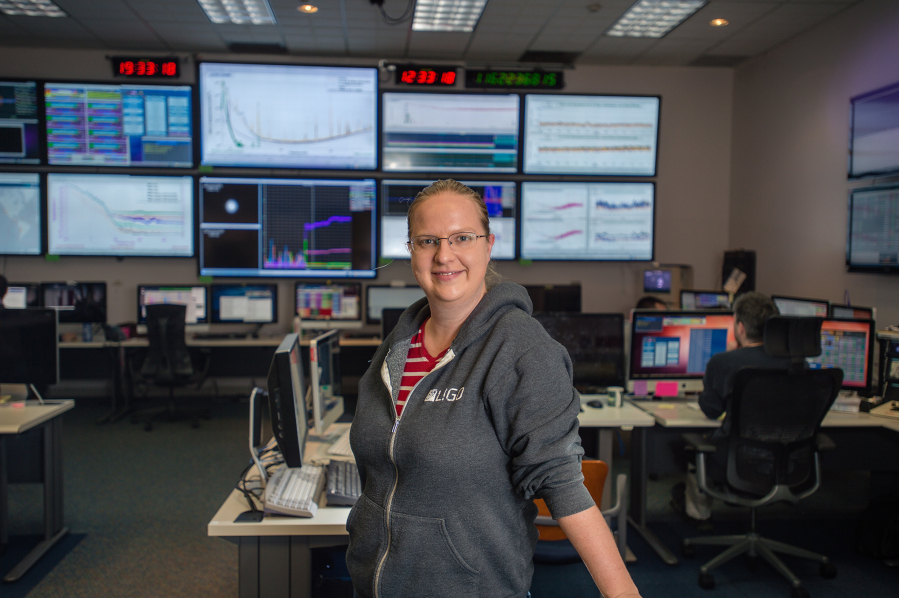Why.
That’s always been an important word for Jenne Driggers.
Even when it seems like a goofy question — “Why do they only refill the office vending machines on Tuesdays?” — the answer can be earth-shaking.
Really.
They have to limit truck traffic at her research laboratory in Hanford. If the ground shakes too much, it can interfere with signals from outer space.
Driggers, who grew up in Vancouver, is part of the LIGO project that recently used data from black holes to confirm Albert Einstein’s century-old theory of gravitational waves.
Formally known as the Laser Interferometer Gravitational-Wave Observatory, its findings in September 2015 were so significant that the lead scientists could earn a Nobel Prize in physics.
If You Go
• What: Free lecture on Laser Interferometer Gravitational-Wave Observatory research.
• Who: Amber Henry, outreach coordinator at Hanford LIGO lab.
• When: 6:30 p.m., March 22 (was originally scheduled for Feb. 9 but was canceled because of weather).
• Where: Heritage High School auditorium, 7825 N.E. 130th Ave., Vancouver.
• Cost: Free.
“It’s very likely,” said Driggers, who went to Evergreen High School.
Driggers is a postdoctoral researcher at California Institute of Technology in Pasadena and is stationed at the Hanford LIGO laboratory.
The scientists credited with creating LIGO include Kip Thorne, physics professor at Caltech, and Rainer “Rai” Weiss, emeritus professor at the Massachusetts Institute of Technology.
In 2016, they were awarded the Special Breakthrough Prize in Fundamental Physics. (They shared it with fellow LIGO cofounder Walter Drever, who died Tuesday.)
Did her part
Driggers had a role in the discovery.
“I have my hands on the actual interferometer every day. I feel a lot of ownership over the data.”
It’s a team spirit that Thorne and Weiss encouraged, Driggers said.
“There was a letter to the lab staff from Kip and Rai: ‘We had the idea. You made it happen.'”
Driggers’ job is to improve the accuracy of the interferometer. She likens it to turning on the radio and listening to music through static and crackle. “We have to get rid of the static and crackle.”
It’s pretty delicate work, since the LIGO data involved something that happened when two black holes collided 1.3 billion years ago.
“A huge amount of energy is released,” said Driggers.
LIGO teams at Hanford and a similar site in Louisiana use laser beams to gauge the energy that shows up in the form of gravitational waves.
A laser beam hits a splitter that sends beams down a pair of identical tubes built at right angles. Mirrors at the end of the 2 1/2 -mile-long tubes bounce the laser beams back to a detector.
They can recombine in two ways. If nothing interferes with the two beams, they cancel each other out and there is no laser light at the detector. If the interferometer shows the slightest bit of laser light, it means that a gravitational wave affected the arms.
Traffic problems
That’s why anything that jiggles the ground is a problem.
“We restrict deliveries to Tuesday mornings,” she said, when the Hanford lab and its LIGO partner in Livingston, La., go offline for four hours.
“The vending machines only get refilled on Tuesday mornings. Liquid oxygen is delivered, and the fire department does its inspections on Tuesdays.”
An earthquake of magnitude 5 or more anywhere in the world shuts down the lab for at least 30 minutes, she said.
“We get one or two of those a week.”
It’s not just a Hanford problem, her father added.
“The detector is so sensitive that Jenne had to do most of her Ph.D. research late at night when there was less automobile and truck traffic near Caltech,” Matt Driggers said.
Her father was a big influence in leading her to the LIGO research, she said. A mechanical engineer for HP Inc., Matt Driggers designs parts for printers.
He wanted his kids to understand that scientific concepts are built into everything we do.
“Science is how you look at the world to see how it works,” he said. “When you drive a car, you’re using science.”
In one of his daughter’s first hands-on projects, “She disassembled the door of car to fix a window.”
It was all part of that sense of inquiry, the 30-year-old physicist said.
“Dad always asked my brothers and I, ‘Why?’ Physics is a way of figuring out why things are what they are.”




